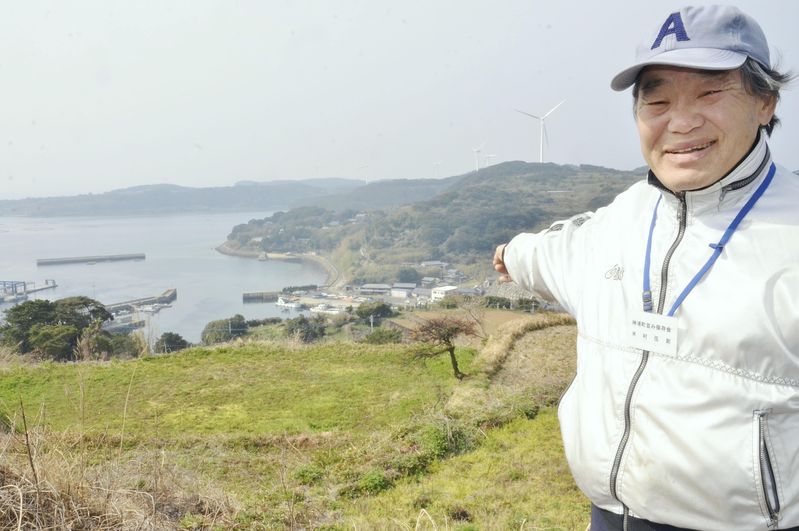The Yomiuri ShimbunNationwide efforts are on the rise to promote so-called health tourism, which takes a different approach to sightseeing by focusing on health. With many provincial regions facing declining populations and dwindling tourist numbers, organizers are competing to create unique plans that utilize each region’s resources and geographical features.
A pollen-free island retreat
By Yoshiko Minami
NAGASAKI—Azuchi-Oshima is a remote island off Hirado, Nagasaki Prefecture. Residents are inviting tourists to come to their “escape-from-pollen resort,” boasting of its very low quantity of cedar pollen in the air.
Cedar forests account for only about 1.6 percent of the island’s total acreage, and what cedar tree pollen there is tends to drift away from the island. Also, pollen from nearby areas does not reach the island.
According to research by Nagasaki University in fiscal 2009, the percentage of islanders suffering from hay fever was about 2.6 percent, compared to the national average of about 26.5 percent. The figure is even lower than the 6 percent in Okinawa Prefecture, where there are no cedar forests.
About 10 islanders run the Hirado branch of Bunkazai Takumi Juku, a nonprofit organization for the preservation of cultural assets that is now organizing Oshima therapy tours.
A single tour accommodates up to 20 visitors, and costs ¥10,000 for a three-night, four-day package. Demand is high, with applications reaching three to four times the available spaces for each tour.
The tour includes a lecture by a doctor specializing in pollen allergies. Forty-three people from various regions, including Kansai and Tohoku, applied for this year’s tour from March 6 to 9.
Keiko Yokoyama, a 72-year-old participant from Kitakyushu, said, “Though I had been troubled by a runny nose, I’ve been able to stay on this island without wearing a mask. I was impressed. It’s also nice that the fee is low and the air feels cleaner than in Hokkaido and Okinawa Prefecture.”
Itsunori Yonemura, the 68-year-old deputy head of the NPO’s Hirado branch, said: “We want to make [the island] more famous as a get-away-from-pollen resort so as many people as possible will visit.”
Forest therapy
By Nana Ando
NAGANO—A nonprofit organization is promoting forest therapy, where tourists nourish their body and mind through physical exercises in forests in Iiyama, Nagano Prefecture.
The Tokyo-based Forest Therapy Society said there were 48 forest therapy bases across the nation as of the end of February. Iiyama was the first such lo-cation to be certified in the NPO’s inaugural inspection in April 2006.
A wide variety of experiences await in the city, including walking and yoga in the summer and trekking come winter time. About 1,500 people visit each year, mainly women in their 30s and 40s.
Located in a region with heavy snowfall, skiing used to be the city’s main tourist attraction in the winter, but the ski boom ended and tourist numbers have been falling year by year. However, the city government has expressed high expectations as forest therapy has been an effective draw in luring summertime tourists.
Fees change according to the seasons, but prices generally hover at about ¥15,000 for a two-day, one-night stay.
One of the more popular courses among middle-aged couples and women includes health checks in a city hospital, followed by nutritionally balanced, low-salt lunches.
“I hope visitors will take a second look at their everyday lifestyles by spending time in forests and using their five senses,” said Kenichi Takano, 37, manager of the Nabekura Kogen Mori no Ie accommodation facility.
Ancient pilgrimage
By Eiko Negishi
TSU—In January, the city government of Owase and other munici-palities in Mie Prefecture began organizing walking tours on Kumano Kodo, an ancient pilgrimage route that is part of the Sacred Sites and Pilgrimage Routes in the Kii Mountain Range, a World Heritage site.
Owase has been troubled by a declining population, prompting munici-palities to promote walking tours as a beneficial activity for good health and beauty.
The city government and Mie University in Tsu jointly researched the health effects of walking on Kumano Kodo for three years, beginning in 2009. Results indicated that walking on stone pavements surrounded by greenery can reduce stress, based on data gathered from electrocardiograms and saliva analysis on participants.
The tours are guided by instructors who are well-versed not only in Kumano Kodo but also in healthy walking methods for effectively burning calories.
Twelve people participated in one of the February tours, in which participants walked through Magose Toge mountain pass on Kumano Kodo. They walked for about 4½ hours, occasionally lying down on big rocks.
source: http://www.the-japan-news.com / The Japan News / by The Yomiuri Shimbun / March 17th, 2014


